Growing a small business through B2B lead generation doesn’t require a massive budget or a huge team. What it does require is a smart, focused approach that leverages the right tools and strategies to compete with larger competitors.
Here’s the reality: according to HubSpot’s State of Marketing 2025 research, 87% of marketers using a unified CRM felt their marketing strategies were effective, compared to only 52% without one. The difference isn’t luck—it’s having the right system in place.
This guide will walk you through building an effective lead generation system tailored specifically for small business constraints and opportunities. No fluff, just actionable strategies backed by real data.
Start with the Basics: Foundation, Channels, and Measurement
Before you dive into tactics, you need three things locked down: clarity on who you’re serving, focus on the right channels, and a way to measure what’s working.
Know Your Ideal Customer Profile (Or Waste Everyone’s Time)
“Small businesses” isn’t an ICP. “E-commerce brands doing $500K-$5M annually who are outgrowing their garage but aren’t ready for a 10,000 SF warehouse commitment” is an ICP.
The specificity matters because it determines everything downstream—your email personalization angle, your partnership targets, your content topics, your local SEO keywords. When you can describe your perfect customer down to the problems keeping them up at night, your conversion rates climb because you’re speaking directly to their situation.
Define your ICP with specificity:
- Industry verticals and company size ranges
- Specific pain points your solution addresses
- Decision-maker titles
- Geographic focus areas
- Budget ranges
The tighter your ICP, the higher your conversion rates. Scatter-shot approaches waste the limited time small businesses have.
Sharpen Your Value Proposition (Or Get Ignored)
Can someone understand your offer in five seconds? Most small business owners know their solution intimately. This proximity makes it harder to see what actually matters to outsiders.
Value Proposition Reality Check:
❌ Generic: “We provide warehouse solutions”
✅ Specific: “WareSpace provides small and growing businesses the perfect warehouse space, ranging from 200-2,000 SF with short-term leases and no surprise costs.
Your value proposition needs to focus on the problem you solve, not the features you’ve built. Prospects don’t care about your “state-of-the-art facility with climate control and loading docks.” They care about avoiding the nightmare of missing their holiday shipping deadlines because their garage setup can’t handle the volume.
Professional presence supports this clarity. Your website should load quickly and explain your offer immediately. Your LinkedIn profile should make your expertise obvious. Even your business address matters—operating from a P.O. box or residential address sends signals about your legitimacy.
Focus on Four High-ROI Channels (Not Fifty)
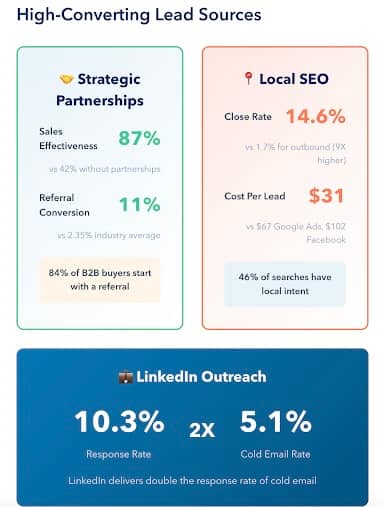
According to HubSpot’s State of Marketing 2025, small businesses need a multi-channel approach focused on channels that actually deliver returns. Here’s what the data says works:
For B2B businesses:
- Website, Blog, and SEO (35%)
- Paid Social Media (28%)
- Social Media Shopping Tools (23%)
For B2C businesses:
- Email Marketing (32%)
- Paid Social Media (30%)
- Content Marketing (27%)
The four channels worth your time:
- Email Marketing – Highest ROI channel
Email generates $36 for every $1 spent, a 3,600% return on investment. According to HubSpot’s research, AI-powered email personalization delivered 82% higher conversion rates, 30% better open rates, and 50% improved click-through rates. The catch? Generic cold emails are dying. Personalized outreach is thriving.
- LinkedIn Outreach – 2X better response rates
LinkedIn outreach generates 10.3% response rates compared to 5.1% for cold email—double the performance. B2B marketers prioritize LinkedIn nearly twice as much as B2C marketers (14% vs 7%) because it’s where business decision-makers spend their time.
- Strategic Partnerships – Highest conversion rates
Companies using partnerships achieve 87% sales effectiveness versus 42% without—more than double the performance. B2B referral conversion rates hit 11% compared to 2.35% across all industries. Yet only 11% of salespeople actually ask for referrals, despite 91% of customers saying they’d give them if asked.
- Local SEO – Best for intent-driven leads
Local SEO leads close at 14.6% compared to just 1.7% for outbound leads—nearly 9X higher conversion. Even if you serve clients nationally, local SEO matters because 46% of all Google searches have local intent.
Everything else is noise. Master these four, and you’ll outperform competitors spreading themselves across a dozen channels.
Measure the Right Things (Or Fly Blind)
According to HubSpot’s B2B Marketer’s Guide, you need to track both leading and lagging indicators.
Leading indicators tell you what’s coming:
- Views, clicks, form fills
- Campaign reach, send volume
- Conversions, leads, pipeline additions
Lagging indicators tell you what happened:
- Revenue, upsells, cross-sells
- Renewals, customer advocacy
- Marketing-attributed revenue, churn rate
Smart marketers watch both. Leading indicators let you course-correct quickly. Lagging indicators tell you if you’re actually winning.
Track these metrics by channel:
- Lead source (where they came from)
- Response rate (for cold email and LinkedIn)
- Conversion rate to meeting
- Conversion rate to customer
- Cost per lead
- Time to close
- Customer lifetime value
Baseline targets to aim for:
- Cold email response rate: 8-15%
- LinkedIn connection acceptance: 20%+
- LinkedIn message reply rate: 10%+
- Referral conversion rate: 10%+
- Local SEO lead close rate: 12%+
Review monthly: what’s working? Double down there. What’s not working? Fix it or kill it. The goal isn’t perfecting every channel—it’s finding your 2-3 highest-ROI channels and systematizing them.
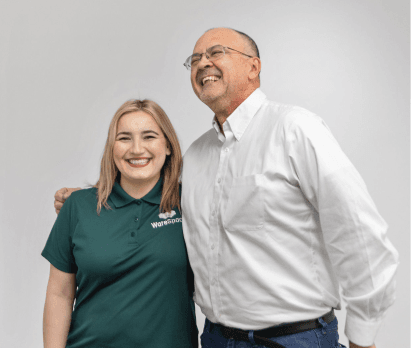
Understanding Your B2B Buyers
It’s Not Just One Person Making the Decision
Here’s something most small business owners don’t realize: even when you’re selling to a “small” business, you’re rarely selling to just one person. According to HubSpot’s B2B Marketer’s Guide to Winning Customers and Proving Success, most B2B buyers sit on a buying committee that collectively makes purchase decisions.
Think about your last few deals. You probably talked to multiple people, right? Maybe you started with someone who loved your product, but then they had to get approval from their boss. Or perhaps IT needed to sign off on security. That’s the buying committee in action.
Understanding these roles helps you craft better messages and know who else might need to be involved. The six key players you’ll encounter are the User (who’ll actually use your product daily), the Technical Evaluator (who checks if it works with their systems), the Champion (your internal advocate), the Executive Sponsor (senior decision-maker), the Economic Buyer (controls the budget), and the Influencer (someone whose opinion matters even without direct authority).
Map the Journey Your Buyers Actually Take
No two customers follow exactly the same path, but when you study enough customer journeys, patterns emerge. Understanding these patterns is how you know where to show up and what to say.
The typical B2B buyer moves through five distinct stages. First, they’re Unaware—they don’t even know they have a problem yet. This is where blog posts, social media, and industry reports introduce them to new ideas.
Then they become Problem-Aware—they realize they have an issue to solve. Now they’re consuming educational content, attending webinars, and reading how-to guides.
Next is Solution-Aware—they’re actively researching possible solutions. This is when they dive into comparison guides, case studies, and expert content to understand their options.
At the Product-Aware stage, they’re evaluating specific products like yours. They’re watching demos, checking pricing pages, and maybe signing up for free trials.
Finally, in the Evaluating stage, they’re making their final decision. This is where sales calls, customer references, and ROI calculators seal the deal.
Build a Marketing Funnel That Fits Your Reality
Marketing funnels get a bad rap for being overly complicated. But here’s the truth: a funnel is just a visual way to understand where your prospects are in their journey and what to do about it.
A funnel helps you do four critical things:
- Know what content to show people based on where they are
- Organize your content by funnel stage
- Measure what’s actually working
- Figure out how to spend your limited time ← This is the big one for small businesses
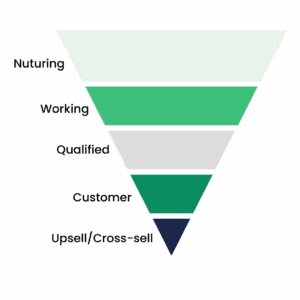
Understanding Each Stage
NEW: These are people who’ve just discovered you—website visitors, trade show contacts, newsletter subscribers. They need education and trust-building, not a sales pitch.
NURTURING: They know about you but aren’t ready to buy. Your job is to stay top-of-mind with regular newsletters, tips and tricks, industry news, and customer success stories.
WORKING (MQL): They’re actively engaging and showing buying signals. This is where you provide comparison guides, ROI calculators, and detailed case studies.
QUALIFIED (SAL/SQL): They’re ready to talk to sales. Time for demos, free trials, pricing information, and customer references.
CUSTOMER: They’ve purchased! Now focus on smooth onboarding, excellent support, and looking for expansion opportunities.
UPSELL/CROSS-SELL: Existing customers who could benefit from additional products or services.
Managing the Exits
Recycles are leads that weren’t ready but might be later. Keep them in your nurture track—they already know you.
Unqualified leads are truly not a fit. Remove these from active marketing to focus your resources where they matter.
Score Your Leads So You Know Where to Focus
Here’s the problem every small business faces: you can’t chase every lead. You have limited time, and you need to spend it on prospects most likely to buy.
This is where lead scoring becomes your secret weapon. Scoring measures how interested a prospect is in your products, typically on a scale of 1-100+.
The framework is straightforward. High-value actions like form submissions, demo requests, and webinar attendance get 50 points. Medium-value actions like video plays and pricing page views get 25 points. Low-value actions like page views get 1-10 points.
But Interest Isn’t Everything—You Need to Grade Fit Too
Grades (A, B, C, D) measure whether they’re a good fit based on company size, industry, location, job title, and department.
When you combine score and grade, magic happens:
- High Priority (Score 75+, Grade A): Ready to buy AND perfect fit
- Good Priority (Score 50-75, Grade A-B): Interested AND good fit
- Watch List (Score 75+, Grade C-D): Very interested BUT not ideal fit
- Long-Term Nurture (Score <50, Grade A-B): Good fit BUT not ready
Disqualify (Score <50, Grade C-D): Not interested AND not a fit
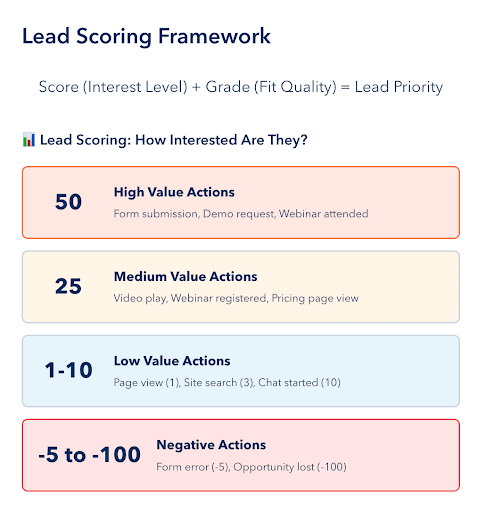
Cold Email: The High-ROI Channel Everyone Does Wrong
The cold email paradox: email delivers $36 for every $1 spent, yet most cold emails get deleted within seconds. Research analyzing 16.5 million B2B emails found that personalizing beyond just first name generates 18% reply rates versus 9% for generic emails—a 2X improvement.
Generic cold emails get deleted. Everyone can spot the mail merge. Real personalization means referencing something specific about the recipient’s business—a recent expansion you noticed, a challenge mentioned in an interview, a company milestone they announced.
The Structure That Actually Works
Research shows that emails between 50-125 words (roughly four to five sentences) achieve the highest response rates, approaching 50%. Three short paragraphs. That’s it.
Paragraph 1: Open with specific personalization. Reference something specific about their company. Not “I noticed you’re in the manufacturing space” (everyone can see that). More like “I saw your Q3 expansion into the Southeast—congrats on the new facility.”
Paragraph 2: State your value quickly. One to two sentences addressing a problem they likely face. Connect it to what you observed in your research. “Most manufacturers expanding into new regions struggle with logistics coordination across multiple sites.”
Paragraph 3: Make a simple ask. No hard sells. Request a 10-minute call, ask a single qualifying question, offer to share a relevant resource. “Worth a quick call to share how three other manufacturers solved this?”
Real example: One WareSpace customer sent 47 cold emails using this structure in their first week. They got 8 responses (17% response rate) and booked 5 calls. Three of those calls turned into customers within 30 days. Total time invested: about 3 hours of research and writing. Total revenue: $47,000 in first-year contracts.
Subject Lines: The Make-or-Break Moment
Personalized subject lines perform 35.69% better than generic ones, with the recipient’s name achieving 43.41% open rates.
The highest-performing format is simply:
“Hi {{first_name}}” at 41.88% open rate, followed by “{{first_name}}, [pain point] at {{company_name}}?” at 40.13%.
The data on subject line optimization:
- Numbers increase open rates by 113%
- Question-based subjects perform 21% higher
- Keep subject lines to 36-50 characters for 24.6% higher response rates
- 33% of people open emails based on subject line alone
Avoid anything that screams “mass email”: “Exciting opportunity for your business,” “I’d love to connect with you,” or “Following up on my previous email.” These get deleted instantly.
The Follow-Up Sequence That Wins Deals
Most deals happen in the follow-up, not the initial email. The first follow-up generates a 49-220% increase in response rates. The second follow-up adds another 9%. The third follow-up sees a 20% decline, so stop there.
Optimal timing: 3 days between follow-ups—this generates 31% more replies compared to following up within 1 day or waiting 5+ days.
Your first follow-up should add value without asking for anything—share a relevant article, insight, or resource specific to their situation. Your second follow-up offers a graceful exit: “Last message from me. If the timing’s not right, totally understand. If you do want to explore [specific value], I’m around Tuesday or Thursday. If not, no hard feelings.”
Multi-Threading: The 93% Response Rate Boost
Emailing 2-4 people from the same company generates 93% higher response rates than contacting a single person. Emailing 5-10 people causes response rates to plummet from 6.1% to 2.5%, so precision matters more than volume.
The sweet spot: identify the likely decision-maker plus one influencer or stakeholder. Send each a personalized email (not a mass email). One responds, or they discuss internally, and suddenly you’re in the conversation.
Technical Setup: The Unsexy Stuff That Kills Campaigns
Proper SPF, DKIM, and DMARC authentication is now mandatory, with 70% of people marking emails as spam based on subject line alone when deliverability signals are weak. Maintain bounce rates under 3-5%. Warm up new domains gradually, starting with 10-20 emails daily, increasing by 10-15% every few days.
Skip the technical setup, and your emails land in spam regardless of how good your copy is. Get it right once, and you’re set for consistent delivery.
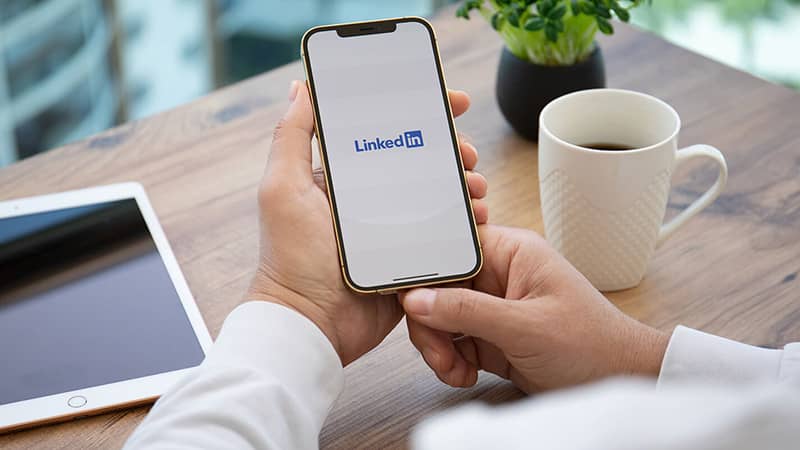
LinkedIn: Where 2X Response Rates Come From Strategy, Not Volume
LinkedIn delivers 2X higher response rates than cold email (10.3% versus 5.1%), making it the highest-performing channel for B2B prospecting. The catch? Most people use LinkedIn like a spray-and-pray email platform, sending generic connection requests and immediately pitching in the first message. That doesn’t work.
The warm-first approach dramatically improves results. Research analyzing LinkedIn outreach shows that subtle touchpoints—viewing profiles, liking posts, following company pages, endorsing skills—before sending connection requests achieves 22% connection approval rates and 7.22% reply rates. That’s a 22% improvement over cold requests.
The 7-Day Warm-Up That Doubles Acceptance Rates
The LinkedIn warm-up isn’t complicated. It’s strategic visibility over one week:
Day 1-2: View their profile. Like their most recent post. The goal is getting on their radar without being pushy.
Day 3: Follow their company page. Like or comment on another piece of their content. Keep comments substantive—2-3 sentences adding insight, not just “Great post!”
Day 4: Send a personalized connection request. Reference something specific from their profile or recent activity. “Hi Jennifer—loved your post about managing seasonal inventory spikes. We work with a lot of e-commerce brands facing that same challenge. Would value connecting.”
Day 5-6: Wait. Let them accept (or not).
Day 7: If they accept, send a thank-you message. Don’t pitch. Acknowledge what you appreciated about their content. Mention you work in a related area. Offer to share insights if ever helpful. Then wait again.
Day 10-14: Engage with their content. Show up consistently as someone who adds value.
Day 15+: Only now, if there’s genuine reason for a business conversation, start that dialogue with specific value: “You mentioned looking at warehouse options for Q4. We just helped three e-commerce brands in similar situations. Worth a quick call to share what worked?”
Timing matters: Monday has the highest acceptance rate at 22.04%, while Thursday at 10 AM is the best time for message replies at 20.32%.
What Happens After They Accept
Once connected, messenger campaigns achieve 16.86% reply rates, event attendee messages get 14.21%, and inbound visitor campaigns (messaging people who viewed your profile) reach 13.4%. The second follow-up is most effective, adding a 4.05% improvement, while first follow-ups show minimal impact and third+ follow-ups offer diminishing returns.
The pattern: provide value first, build relationship second, make business ask third. Most people flip this order and wonder why LinkedIn doesn’t work.
Content Posting: The 70% of Traffic Secret
70% of website traffic and engagement comes from personal profiles rather than company pages. This means your personal LinkedIn presence matters more than your company’s page.
Companies posting weekly see a 5X lift in followers, while video content generates 5X more engagement than static posts. Post 2-3 times weekly. Share insights from your work. Address common challenges your prospects face. Skip the humble-brags and corporate speak. Write like you talk.
When prospects research you before responding to your outreach (and they will), an active profile with useful content signals expertise and legitimacy. A dormant profile with your last post from 2022 signals the opposite.
LinkedIn Sales Navigator: Worth the Investment?
LinkedIn Sales Navigator delivers a 45% average increase in deal size and 29% lift in sales opportunities according to Forrester research. At $99.99/month for the Core plan, it includes 50 InMail messages monthly, advanced filtering across 50+ criteria, and unlimited searches returning 2,500 results.
For small businesses just starting LinkedIn outreach, the free version works fine. Once you’re consistently generating leads through LinkedIn and time becomes the constraint, Sales Navigator’s filtering and InMail features justify the cost.
Build Strategic Partnerships That Actually Generate Leads
The partnership numbers are undeniable:
- Companies using partnerships achieve 87% sales effectiveness versus 42% without—more than double
- B2B companies with referrals experience 70% higher conversion rates
- Average B2B referral conversion rate: 11% compared to 2.35% across all industries
- 84% of B2B decision-makers start the buying process with a referral
Yet only 11% of salespeople ask for referrals, despite 91% of customers saying they’d give them if asked. This gap represents perhaps the largest untapped opportunity in B2B.
Finding the Right Partners
Complementary businesses serve the same audience with different products or services. The furniture maker and interior designer. The e-commerce seller and packaging supplier. The commercial contractor and equipment rental company.
The key word: complementary, not competitive. You’re looking for businesses where customer referrals flow naturally in both directions because you solve adjacent problems.
Start by identifying 3-5 potential partners in your region or industry overlap. Research them thoroughly—understand their business model, service offerings, values, target customers. When you reach out, lead with the specific value you can provide to their clients, not what you want from them.
“Your e-commerce clients probably struggle with fulfillment as they scale—we specialize in solving exactly that problem for businesses in that 50-200 order per day range. Would you be open to exploring a referral partnership?” is infinitely more effective than “We should partner because we’re both in related industries.”
84% of top-quartile companies that outperform peers invest in co-marketing. Joint webinars. Co-branded content. Shared booth space at trade shows. Cross-promotion through email lists. These collaborative efforts expose both businesses to new audiences while demonstrating expertise.
Real example: One WareSpace tenant selling custom furniture partnered with an interior design firm in the same building. The designer refers clients who need custom pieces. The furniture maker recommends the designer for larger projects. Both businesses grew 40% in six months without spending a dollar on advertising. When you share space with other entrepreneurs, these partnerships happen organically.
Building a Referral Program That Actually Gets Used
Effective referral programs (91.2% of them) reward both the referrer and the new customer, typically with $50-$300 gift cards, account credits, or service upgrades in B2B contexts.
The best time to ask: immediately after positive milestones—successful implementations, positive feedback, renewals, when customers volunteer testimonials. These moments of peak satisfaction are when customers feel most compelled to help others find similar solutions.
Start simple: after a customer completes their first successful project with you, send an email. “We’re glad the [specific result] worked out well. Quick question—do you know any other [type of business] who might benefit from [your solution]? We’d love to help them achieve similar results, and we’ll send you [incentive] as a thank you.”
That’s it. No complicated software to start. No elaborate tracking system. Just ask.
Referred customers have 37% higher retention rates and 16% higher lifetime value compared to customers acquired through other channels. The economics work: pay $500 for a referral that brings a customer worth $10,000+ in lifetime value.
Master Local SEO for Intent-Driven Leads
Local SEO leads close at 14.6% compared to just 1.7% for outbound leads—nearly 9X higher conversion rates. This advantage stems from intent: 46% of all Google searches have local intent, meaning nearly half of searchers want something in their immediate area.
Add in mobile behavior: 78% of mobile local searches result in an offline purchase within 24 hours, and 50% of B2B search queries are made on smartphones. When someone searches “warehouse space Denver” on their phone, they’re not doing research for next quarter. They need space now.
The ROI case for local SEO:
- SEO delivers 702% ROI for B2B with break-even at just 7 months
- 70% of B2B marketers say SEO is more effective than PPC
- Organic search drives 51% of website traffic for B2B companies
- Cost comparison: SEO averages $31 cost per lead compared to $66.69 for Google Ads, $102 for Facebook B2B ads, and $811-840 for trade shows
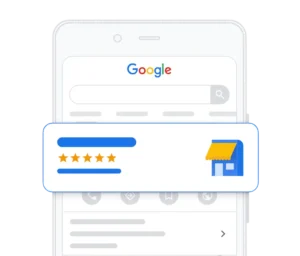
Google Business Profile: The Free Lead Generation Tool
Implementation starts with Google Business Profile optimization, which is completely free. Claim your profile. Add accurate NAP (Name, Address, Phone) information. Post weekly updates with relevant keywords. Respond to all reviews within 24-48 hours.
88% of consumers trust online reviews as much as personal recommendations, and 88% would use a business that replies to all reviews versus 47% that wouldn’t.
Build a systematic review generation process: email satisfied customers 3-5 days after project completion with a direct link to your Google review page. Train team members to ask for reviews during peak satisfaction moments.
Local Content Strategy
Companies that blog generate 67% more leads than those that don’t. Create location-specific blog content addressing local business challenges.
Blog post examples:
- “Denver Warehouse Space: Complete Guide for Small Businesses (2025)”
- “5 Hidden Costs of Warehouse Leases in [Your City]”
- “Best Neighborhoods for Small Business Warehouse Space in [City]”
Each post should target local + service keywords. Include your NAP in text format on every page. Add schema markup so search engines understand your location data.
Use AI to Compete with Bigger Companies
92% of marketers report that AI has impacted their role, with more than a third saying “very significantly.” AI tools that were once available only to enterprises are now accessible to everyone.
Content Creation: Write one blog post, and AI helps you create social posts, email campaigns, video scripts, and more.
Data Analysis: Let AI analyze which campaigns are working, identify trends in customer behavior, and predict which leads will convert.
Personalization: 96% of marketers see increased sales from personalized experiences. AI can personalize emails, landing pages, and recommendations at scale.
Automation: Automated social media scheduling, email workflows triggered by behavior, and smart lead scoring and routing.
Real Results from Real Companies
HubSpot’s demand generation team used AI to analyze user behavior and deliver hyper-personalized content recommendations. The results? 82% higher conversion rates, 30% better open rates, and 50% improved click-through rates.
Phocas Software used HubSpot Breeze’s AI data enrichment and saw 92% of companies in their CRM get automatically enriched with accurate data—improved data quality, better segmentation, and more effective campaigns, all without manual research.
Where to Start with AI
Start with content creation. Use ChatGPT or Claude to generate blog post outlines, social media variations, email subject lines, or video scripts.
Let AI handle lead enrichment. Tools like HubSpot Breeze, Clearbit, or Apollo.io can automatically research companies and contacts.
Use AI for email personalization. Most modern email platforms include AI that can recommend content based on past behavior and optimize send times.
How Professional Infrastructure Amplifies Lead Generation
All of this lead generation work assumes something critical: you have the operational capacity to deliver when leads convert.
When prospects ask “Can you handle this order?” or “When can you ship?” or “Can I see your facility?”—what’s your answer?
Professional warehouse space isn’t just about storing boxes—it’s a legitimate competitive advantage across every lead generation tactic:
Cold email credibility: When prospects Google your company before responding (and they will), seeing an established commercial location signals legitimacy versus a residential address.
Partnership opportunities: Your facility neighbors are potential partners serving complementary markets. The warehouse manager knows other growing businesses. Industry events at the facility connect you with prospects. When you’re physically present in business environments, valuable connections happen organically.
Content creation: Facility tours for prospects. Customer success celebrations. Workshops. Video content. All become possible when you have professional infrastructure.
Flexible scaling: As your lead generation succeeds and customer count grows, co-warehousing space scales with you. You’re not scrambling for new facilities or turning down business because you maxed out capacity.
WareSpace provides small warehouse units (200–2,000 SF) with all-inclusive pricing and essential amenities—basically an operations backbone that lets you focus on sales and growth rather than facility headaches. Short-term leases (6-month minimum) mean you can take on new partnerships or inventory without huge commitments.
Having a proper warehouse and office space gives even a small business the polish of a larger operation when clients visit. You’re among fellow entrepreneurs in a community, not just a lease. The custom furniture maker and interior designer partnership that grew both businesses 40%? That happened because they were in the same building.
If chasing leads is the game, professional co-warehousing levels the playing field. You get the kind of facility and support that only big companies used to afford.
Learn more about what’s included in WareSpace locations.
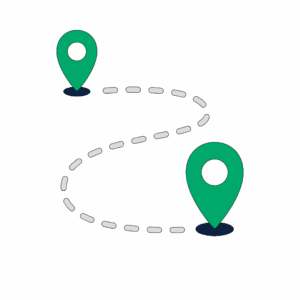
Your 90-Day Implementation Roadmap
Knowing the tactics matters less than executing them systematically. Here’s how to actually implement what you just read.
This Week (5-7 hours total)
Day 1 (90 minutes):
- Claim and completely optimize your Google Business Profile
- Add all photos, services, accurate NAP information
- Write first Google Business Profile post
Day 2 (90 minutes):
- Identify your 20 happiest customers
- Send personal referral request emails to 5 of them
- Set up simple referral tracking spreadsheet
Day 3 (90 minutes):
- List 10 complementary businesses for potential partnerships
- Research the top 3 thoroughly (LinkedIn, website, customer base)
- Draft partnership outreach email to first target
Day 4 (90 minutes):
- Join 3-5 relevant LinkedIn groups or Slack communities
- Spend 30 minutes engaging (answer 2-3 questions, comment on posts)
- Send 3 personalized LinkedIn connection requests using warm-up approach
Day 5 (90 minutes):
- Write 5 personalized cold emails using the research + value + ask structure
- Set up email deliverability (SPF, DKIM, DMARC if not done)
- Send first batch of 5 cold emails
Track from day one: Create a simple spreadsheet tracking lead source, contact date, response date, call booked (yes/no), deal closed (yes/no), and deal value. You can’t optimize what you don’t measure.
This Month (20-25 hours total)
Week 2:
- Launch formal referral program with clear incentives
- Send partnership outreach to 3 complementary businesses
- Continue daily 30-minute community engagement
- Send 15-20 cold emails (3-4 per day)
- Follow up on week 1 cold emails (day 3 follow-up)
Week 3:
- Publish 2 location-specific blog posts targeting local keywords
- Request reviews from 10 recent customers
- Send second follow-up on cold emails (day 8)
- Continue LinkedIn warm-up sequences for new targets
- Schedule partnership exploration calls
Week 4:
- Create 1-2 customer case studies with specific results
- Continue cold email outreach (aim for 50 total for the month)
- Host or attend 1 local business event for in-person networking
- Review week 1-3 metrics and identify highest-performing channel
- Build 15-20 quality local citations (chamber, industry directories)
This Quarter
Month 2:
- Build 30-50 quality citations across directories
- Generate 15-25 Google reviews through systematic requests
- Establish solid partnerships with 1-3 complementary businesses
- Document partnership processes and referral tracking
- Scale cold email to 100+ per month if showing positive ROI
Month 3:
- Host or co-host 1 webinar with a partner
- Continue publishing content consistently (find your sweet spot – like a weekly/biweekly cadence)
- Expand LinkedIn outreach with Sales Navigator (if justified by results)
- Create partnership playbook for scaling successful approaches – and either delegate the work to a freelancer, or internal hire
- Evaluate workspace: does current setup support or hinder growth?
Ready to Scale Your Infrastructure?
Lead generation works when you can actually deliver on what you promise. If you’re operating from inadequate space that limits your credibility, prevents partnership opportunities, or holds back growth, professional co-warehousing might be the infrastructure upgrade that unlocks your entire lead generation strategy.
Book a tour of a WareSpace facility and see how the right space supports the growth tactics you just learned.
When prospects ask “Can you handle this?” you’ll have the space, systems, and community to confidently say yes.
The Bottom Line
The missing piece for most small businesses isn’t knowledge, it’s execution. You now have both the research and the templates.
Send the first emails. Make the partnership asks. Optimize your local presence. Track the results.
Three months from now, you’ll wonder why you didn’t start sooner.
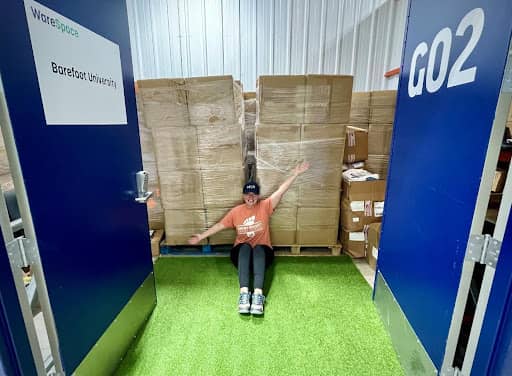
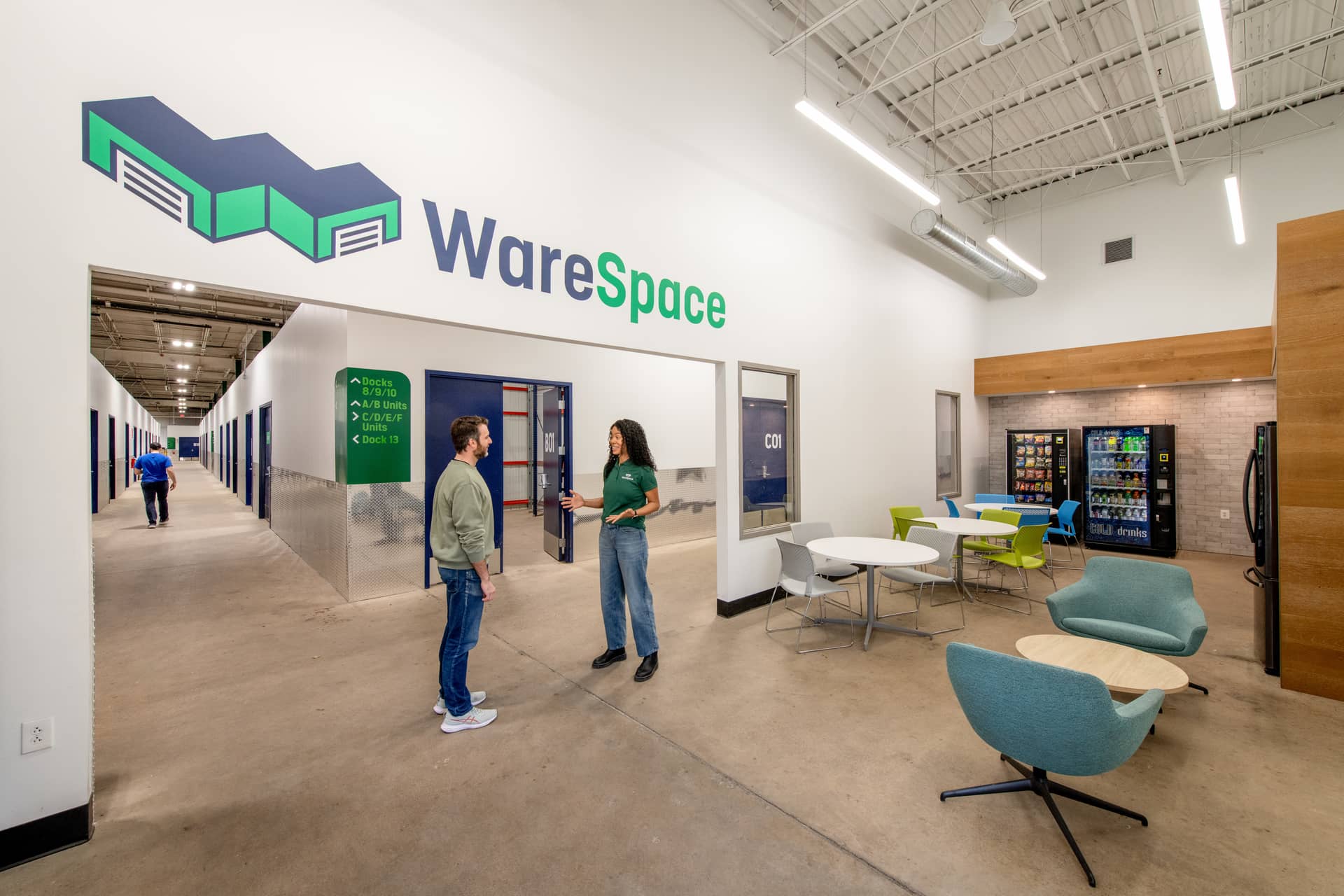


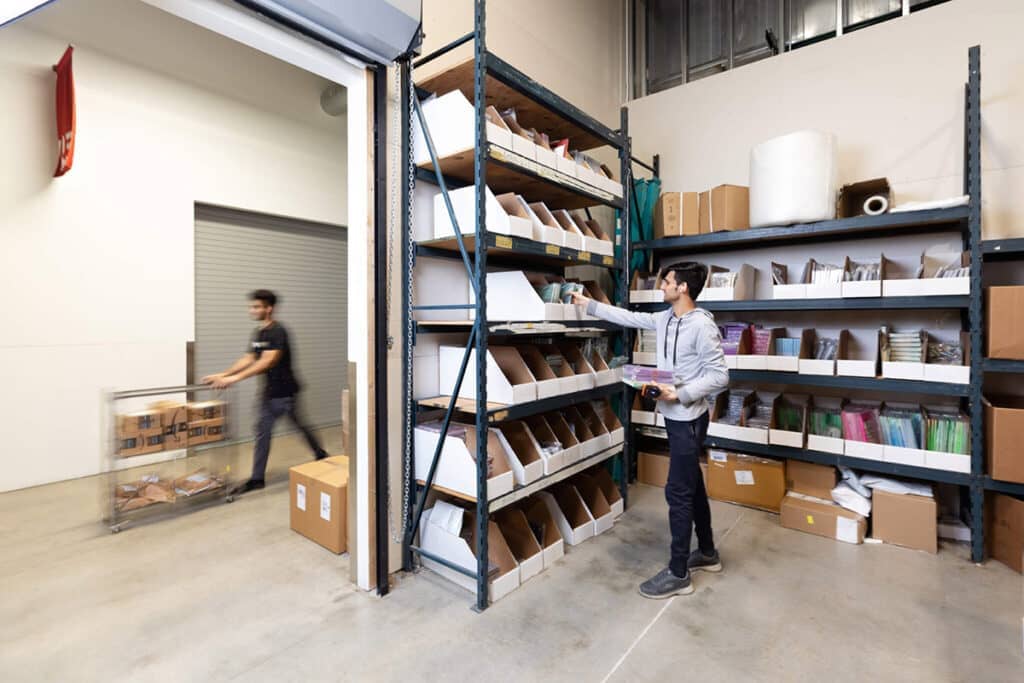
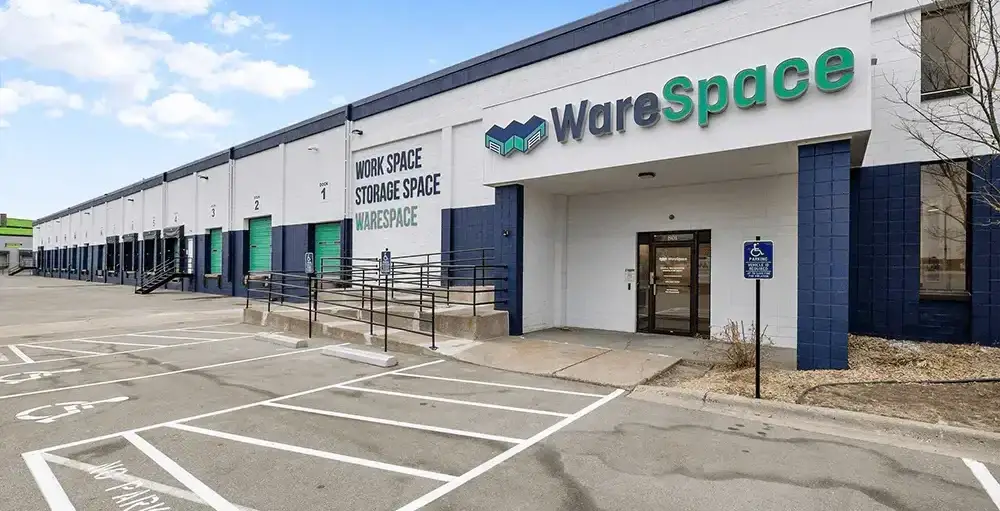
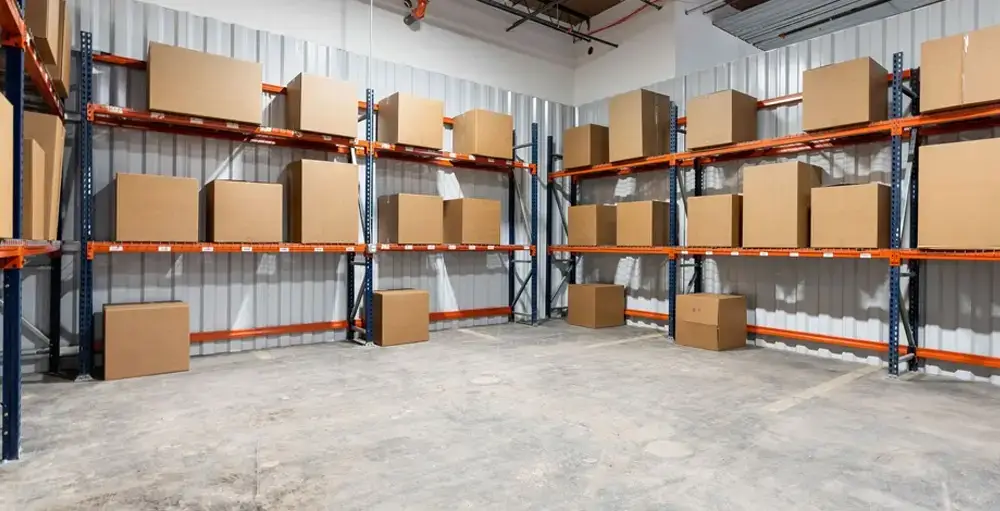
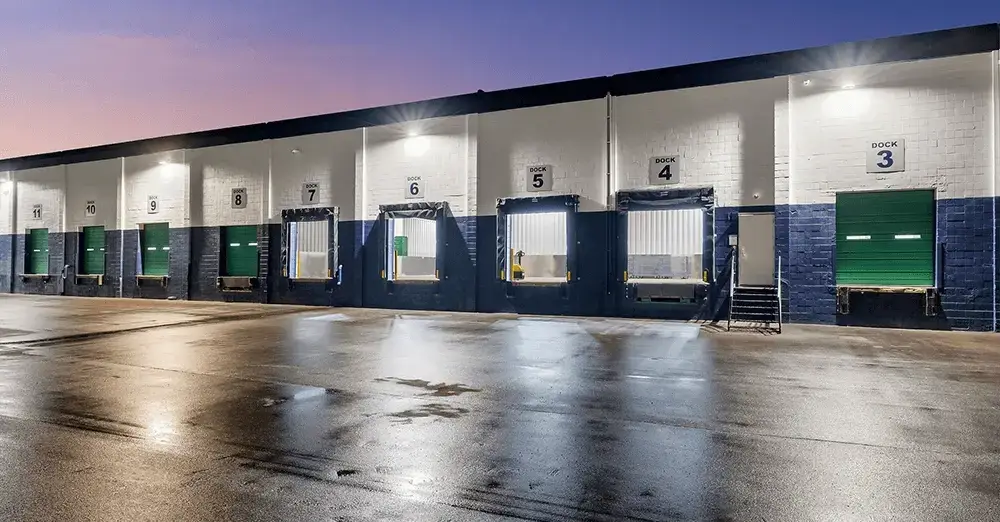
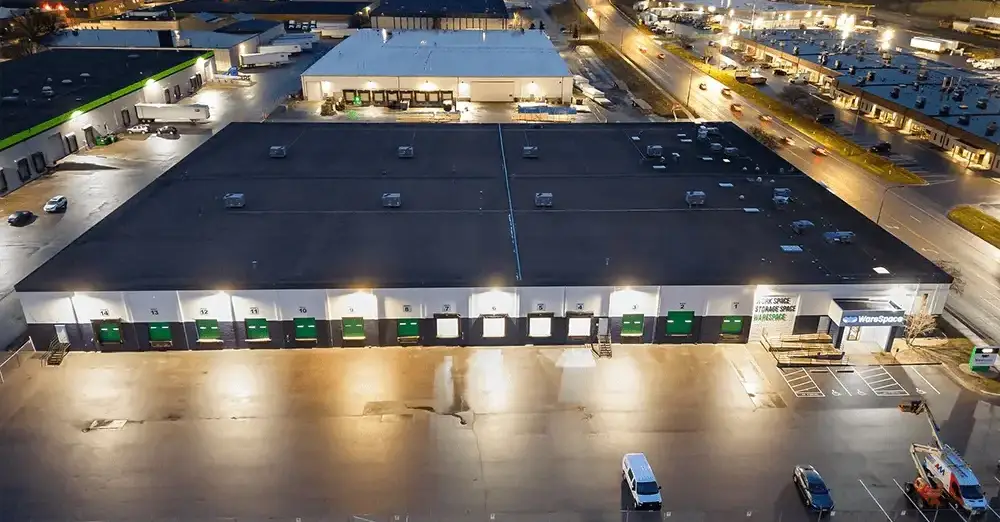











 ►
Explore 3D Space
►
Explore 3D Space